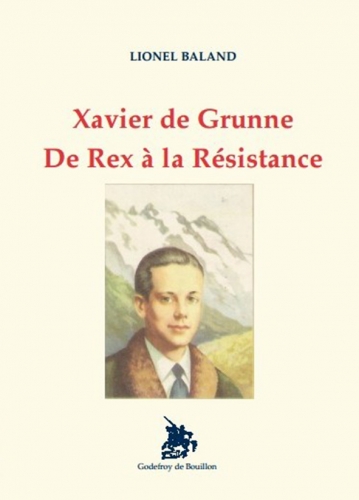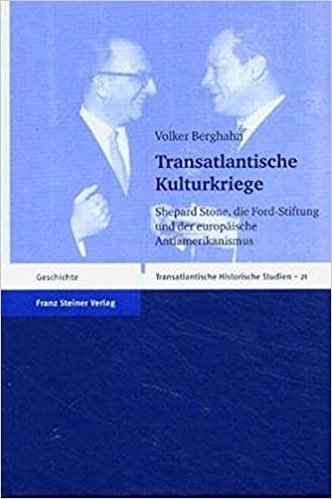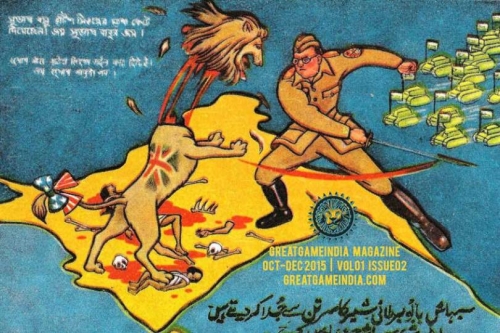Guerra, política y partido
“La revolución proletaria no puede triunfar sin un partido, por fuera de un partido, contra un partido o con un sustituto para un partido. Esa es la principal enseñanza de los diez últimos años” (León Trotsky, Lecciones de Octubre).
El desborde ocurrido en las jornadas del 14 y 18 de diciembre ha puesto sobre la mesa la discusión sobre las relaciones entre guerra y política. A pesar de su campaña contra los “violentos”, el único violento fue el gobierno: reprimiendo una concentración de masas sobre el fondo del repudio masivo a la ley antijubilatoria, era inevitable que su acción represiva desatara una dura respuesta de los sectores movilizados.
La “gimnasia” del enfrentamiento a la represión dejó un sinnúmero de enseñanzas. Entre ellas, una central: las relaciones entre lucha política y lucha física: el pasaje de la lucha política a la acción directa.
Esta problemática ha sido abordada por el marxismo sobre todo a partir de la Revolución Rusa. Si bien con antecedentes en los estudios de Marx y Engels, y también los debates en la socialdemocracia alemana (que tuvo como gran protagonista a Rosa Luxemburgo), fueron Lenin y Trotsky los que le dieron vuelo a las investigaciones sobre las relaciones entre ambos órdenes sociales[1].
La fuente básica de los marxistas ha sido siempre Karl von Clausewitz, oficial del ejército prusiano, que a comienzos del siglo XIX y resumiendo la experiencia de los ejércitos napoleónicos, escribió su clásico tratado De la Guerra que hasta hoy expresa uno de los abordajes más profundos de dicho evento.
Clausewitz iniciaba su estudio con una sentencia que rompía con el sentido común de la época, cuando señalaba que la guerra no es una esfera social autónoma sino “la continuidad de la política bajo otras formas”, formas violentas.
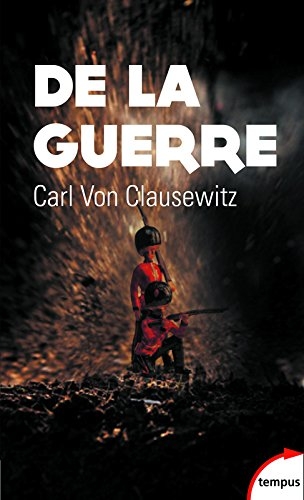 Lenin y Trotsky recuperarían sus definiciones dándoles terrenalidad en la experiencia misma de la revolución: en el evento por antonomasia del pasaje de la política a la lucha física: la ciencia y arte de la insurrección: el momento en que se rompe el continuum de la historia con la intervención de las masas comandadas por el partido revolucionario, que se hacen del poder y cambian la historia.
Lenin y Trotsky recuperarían sus definiciones dándoles terrenalidad en la experiencia misma de la revolución: en el evento por antonomasia del pasaje de la política a la lucha física: la ciencia y arte de la insurrección: el momento en que se rompe el continuum de la historia con la intervención de las masas comandadas por el partido revolucionario, que se hacen del poder y cambian la historia.
Si, en definitiva, la lucha política es una lucha de partidos, la insurrección como evento máximo de traducción de la política al enfrentamiento físico, no tiene otra alternativa que ser comandado por un partido. Volveremos sobre esto.
A la insurrección de Octubre le seguiría la experiencia de Trotsky al frente del Ejército Rojo durante la guerra civil; las enseñanzas desprendidas de dicho evento.
A partir de la experiencia, y de la elaboración teórica desprendida de la misma, se fue forjando un corpus de conceptos, donde un lugar no menor lo ocupan las categorías de estrategia y táctica; la estrategia, que tiene que ver con el conjunto total de los enfrentamientos que llevan al triunfo en la confrontación; la táctica, relacionada con los momentos parciales de dicho enfrentamiento: los momentos específicos donde se pone a prueba la estrategia misma; estrategia que, como decía Clausewitz, debe entrar en el combate con el ejército y corregirse a la luz de sus desarrollos.
De ahí que esta elaboración tenga que ver con el pasaje de la política a la guerra: con aquel momento donde los enfrentamientos se sustancian en el lenguaje de la lucha física; lucha física que, de todas maneras, siempre está comandada por la política: “Bajo el influjo de Sharnhorst, Clausewitz se interesó por la visión histórica de la guerra (…) y llega a la temprana conclusión de que la política es el ‘alma’ de la guerra” (José Fernández Vega, Carl von Clausewitz. Guerra, política y filosofía).
La guerra como continuidad de la política
Desde Clausewitz guerra y política son esferas estrechamente relacionadas. Lenin y Trotsky retomaron esta definición del gran estratega militar alemán de comienzos del siglo XIX. Se apoyaron en Engels, que ya a mediados del siglo XIX le había comentado a Marx el “agudo sentido común” de los escritos de Clausewitz. También Franz Mehring, historiador de la socialdemocracia alemana y uno de los aliados de Rosa Luxemburgo, se había interesado por la historia militar y reivindicaba a Clausewitz.
Por otra parte, hacia finales de la II Guerra Mundial, en el pináculo de su prestigio, Stalin rechazó a Clausewitz con el argumento de que la opinión favorable que tenía Lenin acerca de éste se debía a que “no era especialista en temas militares”…
Pierre Naville señalaría que el Frente Oriental y el triunfo militar del Ejército Rojo sobre la Wehrmacht, había confirmado la tesis contraria: la validez de Clausewitz y lo central de sus intuiciones militares; entre otras, la importancia de las estrategias defensivas en la guerra.
Según su famosa definición, para Clausewitz “la guerra es la continuación de la política por otros medios”. Quedaba así establecida una relación entre guerra y política que el marxismo hizo suya. La guerra es una forma de las relaciones sociales cuya lógica está inscripta en las relaciones entre los Estados, pero que el marxismo ubicó, por carácter transitivo, en la formación de clase de la sociedad. La guerra, decía Clausewitz, debe ser contemplada “como parte de un todo”, y ese todo es la política, cuyo contenido, para el marxismo, es la lucha de clases.
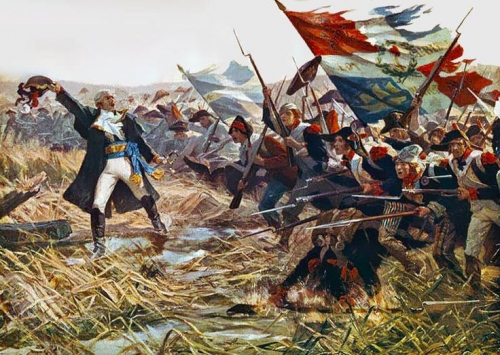
Con agudeza, el teórico militar alemán sostenía que la guerra debía ser vista como un “elemento de la contextura social”, que es otra forma de designar un conflicto de intereses solucionado de manera sangrienta, a diferencia de los demás conflictos.
Esto no quiere decir que la guerra no tenga sus propias especificidades, sus propias leyes, que requieren de un análisis científico de sus determinaciones y características. Desde la Revolución Francesa, pasando por las dos guerras mundiales y las revoluciones del siglo XX, la ciencia y el arte de la guerra se enriquecieron enormemente. Tenemos presentes las guerras bajo el capitalismo industrializado y las sociedades pos-capitalistas como la ex URSS, y el constante revolucionamiento de la ciencia y la técnica guerrera.
Las relaciones entre técnica y guerra son de gran importancia; ya Marx había señalado que muchos desarrollos de las fuerzas productivas ocurren primero en el terreno de la guerra y se generalizan después a la economía civil.
Las dos guerras mundiales fueron subproducto del capitalismo industrial contemporáneo: la puesta en marcha de medios de destrucción masivos, el involucramiento de las grandes masas, la aplicación de los últimos desarrollos de la ciencia y la técnica a la producción industrial y a las estrategias de combate (Traverso).
Esto dio lugar a toda la variedad imaginable en materia de guerra de posiciones y de maniobra: con cambios de frente permanentes y de magnitud, con la aparición de la aviación, los medios acorazados, los submarinos, la guerra química y nuclear y un largo etcétera[2].
Como conclusión, cabe volver a recordar lo señalado por Trotsky a partir de su experiencia en la guerra civil: no hay que atarse rígidamente a ninguna de las formas de la lucha: la ofensiva y la defensa son características que dependen de las circunstancias. Y, en su generalidad, la experiencia de la guerra ha consagrado la vigencia de las enseñanzas de Clausewitz, que merecen un estudio profundo por parte de la nueva generación militante.
La política como “guerra de clases”
Ahora bien, si la guerra es la continuidad de la política por otros medios, a esta fórmula le cabe cierta reversibilidad: “Si la guerra puede ser definida como la continuidad de la política por otros medios, [la política] deviene, recíprocamente, la continuidad de la guerra fuera de sus límites por sus propios medios. Ella también es un arte del tiempo quebrado, de la coyuntura, del momento propicio para arribar a tiempo ‘al centro de la ocasión” (Bensaïd, La política como arte estratégico).
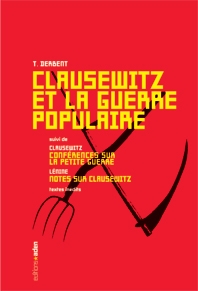 De ahí que muchos de los conceptos de la guerra se vean aplicados a la política, ya que ésta es, como la guerra, un campo para hacer valer determinadas relaciones de fuerza. Sin duda, las relaciones de fuerza políticas se hacen valer mediante un complejo de relaciones mayor y más rico que el de la violencia desnuda, pero en el fondo en el terreno político también se trata de vencer la resistencia del oponente.
De ahí que muchos de los conceptos de la guerra se vean aplicados a la política, ya que ésta es, como la guerra, un campo para hacer valer determinadas relaciones de fuerza. Sin duda, las relaciones de fuerza políticas se hacen valer mediante un complejo de relaciones mayor y más rico que el de la violencia desnuda, pero en el fondo en el terreno político también se trata de vencer la resistencia del oponente.
En todo caso, la política como arte ofrece más pliegues, sutilezas y complejidades que la guerra, como señalaría Trotsky, que agregaba que la guerra (y ni hablar cuando se trata de la guerra civil, su forma más cruenta), debe ser peleada ajustándose a sus propias leyes, so pena de sucumbir: “Clausewitz se opone a las concepciones absolutistas de la guerra [que la veían como una suerte de ceremonia y de juego] y enfatiza el ‘elemento brutal’ que toda guerra contiene” (Vega, ídem).
De allí que se pueda definir a la política (metafóricamente) como continuidad de la “guerra” que cotidianamente se sustancia entre las clases sociales explotada y explotadora. Así, la política es una manifestación de la guerra de clases que recorre la realidad social bajo la explotación capitalista. Esta figura puede ayudar a apreciar la densidad de lo que está en juego, superando la mirada a veces ingenua de las nuevas generaciones.
Nada de esto significa que tengamos una concepción militarista de las cosas. Todo lo contrario: el militarismo es una concepción reduccionista que pierde de vista el espesor de la política revolucionaria, y que deja de lado a las grandes masas, reemplazadas por la técnica y el herramental de guerra, a la hora de los eventos históricos.
Es característico del militarismo hacer primar la guerra sobre la política, algo común tanto a las políticas de las potencias imperialistas como a las formaciones guerrilleras pequeño-burguesas de los años 70: perdían de vista a las grandes masas como actores y protagonistas de la historia.
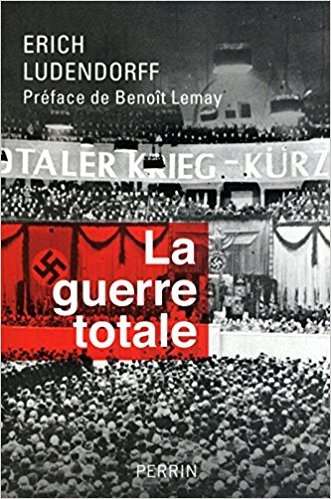 Tal era la posición del general alemán de la I Guerra Mundial, Erich von Ludendorff, autor de la obra La guerra total (1935), donde criticaba a Clausewitz desde una posición reduccionista que ponía en el centro de las determinaciones a la categoría de “guerra total”, a la que independizaba de la política negando el concepto clausewitziano de “guerra absoluta”, que necesariamente se ve limitado por las determinaciones políticas.
Tal era la posición del general alemán de la I Guerra Mundial, Erich von Ludendorff, autor de la obra La guerra total (1935), donde criticaba a Clausewitz desde una posición reduccionista que ponía en el centro de las determinaciones a la categoría de “guerra total”, a la que independizaba de la política negando el concepto clausewitziano de “guerra absoluta”, que necesariamente se ve limitado por las determinaciones políticas.
A su modo de ver De la guerra era “el resultado de una evolución histórica hoy anacrónica y desde todo punto de vista sobrepasada” (Darío de Benedetti, ídem).
Para Ludendorff y los teóricos del nazismo, lo “originario” era el “estado de guerra permanente”; la política, solamente uno de sus instrumentos. De ahí que se considerara la paz simplemente como “un momento transitorio entre dos guerras”.
En esa apelación a la “guerra total” las masas, el Volk, eran vistas como un instrumento pasivo: pura carne de cañón en la contienda: “Ludendorff olvida el factor humano, las fuerzas morales según Clausewitz, como factor decisivo de toda movilización (…) [apela a] un verdadero proceso de cosificación, que permite una total disposición de medios para su alcance” (de Benedetti, ídem).
Pero lo cierto es lo contrario: si la guerra no es más que la continuidad de la política por medios violentos, es la segunda la que fija los objetivos de la primera: “En el siglo XVIII aún predominaba la concepción primitiva según la cual la guerra es algo independiente, sin vinculación alguna con la política, e, inclusive, se concebía la guerra como lo primario, considerando la política más bien como un medio de la guerra; tal es el caso de un estadista y jefe de campo como fue el rey Federico II de Prusia. Y en lo que se refiere a los epígonos del militarismo alemán, los Ludendorff y Hitler, con su concepción de la ‘guerra total’, simplemente invirtieron la teoría de Clausewitz en su contrario antagónico” (AAVV, Clausewitz en el pensamiento marxista).
Con esta suerte de “analogía” entre la política y la guerra lo que buscamos es dar cuenta de la íntima conflictividad de la acción política; superar toda visión ingenua o parlamentarista de la misma. La política es un terreno de disputa excluyente donde se afirman los intereses de la burguesía o de la clase obrera. No hay conciliación posible entre las clases en sentido último; esto le confiere todos los rasgos de guerra implacable a la lucha política.
La política revolucionaria, no la reformista u electoralista, tiene esa base material: la oposición irreconciliable entre las clases, como destacara Lenin. Lo que no obsta para que los revolucionarios tengamos la obligación de utilizar la palestra parlamentaria, hacer concesiones y pactar compromisos.
Pero la utilización del parlamento, o el uso de las maniobras, debe estar presidida por una concepción clara acerca de ese carácter irreconciliable de los intereses de clase, so pena de una visión edulcorada de la política, emparentada no con las experiencias de las grandes revoluciones históricas, sino con los tiempos posmodernos y “destilados” de la democracia burguesa y el “fin de la historia” que, como señalara Bensaïd, pretenden reducir a cero la idea misma de estrategia.

Crítica del militarismo
El criterio principista de tipo estratégico que preside al marxismo revolucionario es que todas las tácticas y estrategias deben estar al servicio de la autodeterminación revolucionaria de la clase obrera, de su emancipación. Sobre la base de las lecciones del siglo XX, debe ser condenado el sustituismo social de la clase obrera como estrategia y método para lograr los objetivos emancipatorios del proletariado.
El sustituismo como estrategia, simplemente, no es admisible para los socialistas revolucionarios. Toda la experiencia del siglo XX atestigua que si no está presente la clase obrera, su vanguardia, sus organismos de lucha y poder, sus programas y partidos, si no es la clase obrera con sus organizaciones la que toma el poder, la revolución no puede progresar de manera socialista: queda congelada en el estadio de la estatización de los medios de producción, lo que, a la postre, no sirve a los objetivos de la acumulación socialista sino de la burocracia.
Un ejemplo vivido por los bolcheviques a comienzos de 1920 fue la respuesta al ataque desde Polonia decidida por el dictador Pilsudsky en el marco de la guerra civil, ataque que desató una contraofensiva del Ejército Rojo que atravesó la frontera rusa y llegó hasta Varsovia. Durante unas semanas dominó el entusiasmo que “desde arriba”, militarmente, se podía extender la revolución. Uno de los principales actores de este empuje fue el talentoso y joven general Tujachevsky (asesinado por Stalin en las purgas de los años 30[3]).
Esta acción fue explotada por la dictadura polaca de Pilsudsky como “un avasallamiento de los derechos nacionales polacos”, y no logró ganar el favor de las masas obreras y mucho menos campesinas, por lo que terminó en un redondo fracaso.

Trotsky, que con buen tino se había opuesto a la misma[4], sacó la conclusión que una intervención militar en un país extranjero desde un Estado obrero, puede ser un punto de apoyo secundario y/o auxiliar en un proceso revolucionario, nunca la herramienta fundamental: “En la gran guerra de clases actual la intervención militar desde afuera puede cumplir un papel concomitante, cooperativo, secundario. La intervención militar puede acelerar el desenlace y hacer más fácil la victoria, pero sólo cuando las condiciones sociales y la conciencia política están maduras para la revolución. La intervención militar tiene el mismo efecto que los fórceps de un médico; si se usan en el momento indicado, pueden acortar los dolores del parto, pero si se usan en forma prematura, simplemente provocarán un aborto” (en E. Wollenberg, El Ejército Rojo, p. 103).
De ahí que toda la política, la estrategia y las tácticas de los revolucionarios deban estar al servicio de la organización, politización y elevación de la clase obrera a clase dominante; que no sea admisible su sustitución a la hora de la revolución social por otras capas explotadas y oprimidas aparatos políticos y/o militares ajenos a la clase obrera misma (otra cosa son las alianzas de clases explotadas y oprimidas imprescindibles para tal empresa).
El criterio de la autodeterminación y centralidad de la clase obrera en la revolución social, es un principio innegociable. Y no sólo es un principio: hace a la estrategia misma de los socialistas revolucionarios en su acción.
Otra cosa es que las relaciones entre masas, partidos y vanguardia sean complejas, no admitan mecanicismos. Habitualmente los factores activos son la amplia vanguardia y las corrientes políticas, mientras que las grandes masas se mantienen pasivas y sólo entran en liza cuando se producen grandes conmociones, algo que, como decía Trotsky, era signo inequívoco de toda verdadera revolución.
Ocurre una inevitable dialéctica de sectores adelantados y atrasados en el seno de la clase obrera a la hora de la acción política; no se debe buscar el “mínimo común denominador” adaptándose a los sectores atrasados sino, por el contrario, ganar la confianza de los sectores más avanzados para empujar juntos a los más atrasados.
Incluso más: puede haber circunstancias de descenso en las luchas del proletariado y el partido -más aún si está en el poder- verse obligado a ser una suerte de nexo o “puente” entre el momento actual de pasividad y un eventual resurgimiento de las luchas en un período próximo. No tendrá otra alternativa que “sustituir”, transitoriamente, la acción de la clase obrera en defensa de sus intereses inmediatos e históricos.
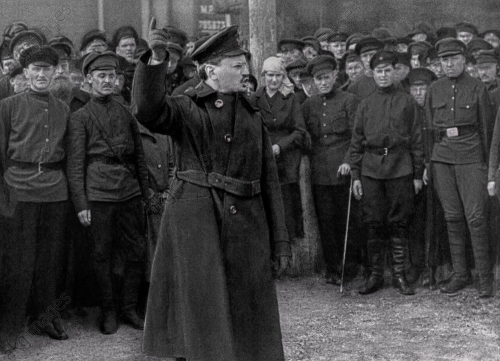
Algo de esto afirmaba Trotsky que le había ocurrido al bolchevismo a comienzos de los años 20, luego de que la clase obrera y las masas quedaran exhaustas a la salida de la guerra civil[5]. Pero el criterio es que aun “sustituyéndola”, se deben defender los intereses inmediatos e históricos de la clase obrera. Y esta “sustitución” sólo puede ser una situación transitoria impuesta por las circunstancias, so pena de transformarse en otra cosa[6].
Ya la teorización del sustituismo social de la clase obrera en la revolución socialista pone las cosas en otro plano: es una justificación de la acción de una dirección burocrática y/o pequeñoburguesa que, si bien puede terminar yendo más lejos de lo que ella preveía en el camino del anticapitalismo, nunca podrá sustituir a la clase obrera al frente del poder. Porque esto amenaza que se terminen imponiendo los intereses de una burocracia y no los de la clase obrera (como ocurrió en el siglo XX).
Quebrar el movimiento inercial
De lo anterior se desprende otra cuestión: la apelación a los métodos de lucha de la clase obrera en contra del terrorismo individual o de las minorías que empuñan las armas en “representación” del conjunto de los explotados y oprimidos.
En el siglo pasado han habido muchas experiencias: el caso de las formaciones guerrilleras latinoamericanas, y del propio Che Guevara, que excluían por definición los métodos de lucha de masas en beneficio de los “cojones”: una “herramienta central” de la revolución, porque la clase obrera estaba, supuestamente, “aburguesada”…
Un caso similar fue el del PCCh bajo Mao. La pelea contra el sustituismo social de la clase obrera tiene que ver con que los revolucionarios no “inventamos nada”: no creamos artificialmente los métodos de pelea y los organismos de lucha y poder. Más bien ocurre lo contrario: buscamos hacer consciente su acción, generalizar esas experiencias e incorporarlas al acervo de enseñanzas de la clase obrera.
 Esta era una preocupación característica de Rosa Luxemburgo, que insistía en la necesidad de aprender de la experiencia real de la clase obrera, contra el conservadurismo pedante y de aparato de la vieja socialdemocracia.
Esta era una preocupación característica de Rosa Luxemburgo, que insistía en la necesidad de aprender de la experiencia real de la clase obrera, contra el conservadurismo pedante y de aparato de la vieja socialdemocracia.
Vale destacar también la ubicación de Lenin frente al surgimiento de los soviets en 1905. Los “bolcheviques de comité”, demasiado habituados a prácticas sectarias y conservadoras, se negaban a entrar en el Soviet de Petrogrado porque éste “no se declaraba bolchevique”… Lenin insistía que la orientación debía ser “Soviets y partido”, no contraponer de manera pedante y ultimatista, unos y otros.
Sobre la cuestión del armamento popular rechazamos las formaciones militares que actúan en sustitución de la clase obrera, así como el terrorismo individual, y por las mismas razones. Pero debemos dejar a salvo no sólo la formación de ejércitos revolucionarios como el Ejército Rojo, evidentemente, también experiencias como la formación de milicias obreras y populares o las dependientes de las organizaciones revolucionarias.
Este último fue el caso del POUM y los anarquistas en la Guerra Civil española, más allá del centrismo u oportunismo de su política. Y podrían darse circunstancias similares en el futuro que puedan ser englobadas bajo la orientación del armamento popular.
Agreguemos algo más vinculado a la guerra de guerrillas. En Latinoamérica, en la década del 70, las formaciones foquistas o guerrilleras, rurales o urbanas, reemplazaban con sus “acciones” la lucha política revolucionaria (las acciones de masas y la construcción de partidos de la clase obrera).
Sin embargo, este rechazo a la guerra de guerrillas como estrategia política, no significa descartarla como táctica militar. Si es verdad que se trata de un método de lucha habitualmente vinculado a sectores provenientes del campesinado (o de sectores más o menos “desclasados”), bajo condiciones extremas de ocupación militar del país por fuerzas imperialistas, no se debe descartar la eventualidad de poner en pie formaciones de este tipo íntimamente vinculadas a la clase trabajadora. Esto con un carácter de fuerza auxiliar similar a una suerte de milicia obrera, y siempre subordinada al método de lucha principal, que es la lucha de masas[7].
Pasemos ahora a las alianzas de clases y la hegemonía que debe alcanzar la clase obrera a la hora de la revolución. Si la centralidad social en la revolución corresponde a la clase obrera, ésta debe tender puentes hacia el resto de los sectores explotados y oprimidos.
Para que la revolución triunfe, debe transformarse en una abrumadora mayoría social. Y esto se logra cuando la clase obrera logra elevarse a los intereses generales y a tomar en sus manos las necesidades de los demás sectores explotados y oprimidos.
Es aquí donde el concepto de alianza de clases explotadas y oprimidas se transforma en uno análogo: hegemonía. La hegemonía de la clase obrera a la hora de la revolución socialista corresponde al convencimiento de los sectores más atrasados, de las capas medias, del campesinado, de que la salida a la crisis de la sociedad ya no puede provenir de la mano de la burguesía, sino solamente del proletariado.
 Este problema es clásico a toda gran revolución. Si la Revolución Francesa de 1789 logró triunfar es porque desde su centro excluyente, París, logró arrastrar tras de sí al resto del país. Algo que no consiguió la Comuna de París cien años después, lo que determinó su derrota. El mismo déficit tuvo el levantamiento espartaquista de enero de 1919 en Alemania, derrotado a sangre y fuego porque el interior campesino y pequeño-burgués no logró ser arrastrado. Multitudinarias movilizaciones ocurrían en Berlín enfervorizando a sus dirigentes (sobre todo a Karl Liebknecht; Rosa era consciente de que se iba al desastre), mientras que en el interior el ejército alemán se iba reforzando y fortaleciendo con el apoyo del campesinado y demás sectores conservadores.
Este problema es clásico a toda gran revolución. Si la Revolución Francesa de 1789 logró triunfar es porque desde su centro excluyente, París, logró arrastrar tras de sí al resto del país. Algo que no consiguió la Comuna de París cien años después, lo que determinó su derrota. El mismo déficit tuvo el levantamiento espartaquista de enero de 1919 en Alemania, derrotado a sangre y fuego porque el interior campesino y pequeño-burgués no logró ser arrastrado. Multitudinarias movilizaciones ocurrían en Berlín enfervorizando a sus dirigentes (sobre todo a Karl Liebknecht; Rosa era consciente de que se iba al desastre), mientras que en el interior el ejército alemán se iba reforzando y fortaleciendo con el apoyo del campesinado y demás sectores conservadores.
Precisamente en esa apreciación fundaba Lenin la ciencia y el arte de la insurrección: en una previsión que debía responder a un análisis lo más científico posible, pero también a elementos intuitivos, acerca de qué pasaría una vez que el proletariado se levantase en las ciudades.
El proletariado se pone de pie y toma el poder en la ciudad capital. Pero la clave de la insurrección, y la revolución misma, reside en si logra arrastrar activamente o, al menos, logra un apoyo pasivo, tácito, o incluso la “neutralidad amistosa” (Trotsky), de las otras clases explotadas y oprimidas en el interior.
De ahí que alianza de clases, hegemonía y ciencia y arte de la insurrección tengan un punto de encuentro en el logro de la mayoría social de la clase obrera a la hora de la toma del poder.
Una apreciación que requerirá de todas las capacidades de la organización revolucionaria en el momento decisivo, y que es la mayor prueba a la que se puede ver sometido un partido digno de tal nombre: “Todas estas cartas [se refiere a las cartas de Lenin a finales de septiembre y comienzos de octubre de 1917], donde cada frase estaba forjada sobre el yunque de la revolución, presentan un interés excepcional para caracterizar a Lenin y apreciar el momento. Las inspira el sentimiento de indignación contra la actitud fatalista, expectante, socialdemócrata, menchevique hacia la revolución, que era considerada como una especie de película sin fin. Si en general el tiempo es un factor importante de la política, su importancia se centuplica en la época de guerra y de revolución. No es seguro que se pueda hacer mañana lo que puede hacerse hoy (…).
“Pero tomar el poder supone modificar el curso de la historia. ¿Es posible que tamaño acontecimiento deba depender de un intervalo de veinticuatro horas? Claro que sí. Cuando se trata de la insurrección armada, los acontecimientos no se miden por el kilómetro de la política, sino por el metro de la guerra. Dejar pasar algunas semanas, algunos días; a veces un solo día sin más, equivale, en ciertas condiciones, a la rendición de la revolución, a la capitulación (…).
“Desde el momento en que el partido empuja a los trabajadores por la vía de la insurrección, debe extraer de su acto todas las consecuencias necesarias. À la guerre comme à la guerre [en la guerra como en la guerra]. Bajo sus condiciones, más que en ninguna otra parte, no se pueden tolerar las vacilaciones y las demoras. Todos los plazos son cortos. Al perder tiempo, aunque no sea más que por unas horas, se le devuelve a las clases dirigentes algo de confianza en sí mismas y se les quita a los insurrectos una parte de su seguridad, pues esta confianza, esta seguridad, determina la correlación de fuerzas que decide el resultado de la insurrección” (Trotsky, Lecciones de Octubre).
El partido como factor decisivo de las relaciones de fuerzas
Veremos someramente ahora el problema del partido como factor organizador permanente y como factor esencial de la insurrección.
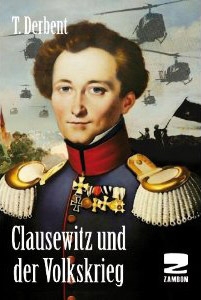 El partido no agrupa a los trabajadores por su condición de tales sino solamente aquéllos que han avanzado a la comprensión de que la solución a los problemas pasa por la revolución socialista: el partido agrupa a los revolucionarios y no a los trabajadores en general (cuya abrumadora mayoría es de ideología burguesa, reformista y no revolucionaria).
El partido no agrupa a los trabajadores por su condición de tales sino solamente aquéllos que han avanzado a la comprensión de que la solución a los problemas pasa por la revolución socialista: el partido agrupa a los revolucionarios y no a los trabajadores en general (cuya abrumadora mayoría es de ideología burguesa, reformista y no revolucionaria).
Quienes se agrupan bajo un mismo programa constituyen un partido. Pero si sus militantes no construyen el partido, no lo construye nadie: el partido es lo menos objetivo y espontáneo que hay respecto de las formas de la organización obrera: requiere de un esfuerzo consciente y adicional, con leyes propias.
Un problema muy importante es el de la combinación de los intereses del movimiento en general y los del partido en particular a la hora de la intervención política. Un error habitual es sacrificar unos en el altar de los otros.
En el caso de las tendencias más burocráticas, lo que se sacrifica son los intereses generales de los trabajadores en función de los del propio aparato. Ya Marx sostenía que los comunistas sólo se caracterizaban por ser los que, en cada caso, hacían valer los intereses generales del movimiento.
Pero es también una concepción falsa creer que los intereses del partido nunca valen; que sólo vale el interés “general”, sacrificando ingenuamente los intereses del propio partido.
Así se hace imposible construir el partido, cuya mecánica de construcción es la menos “natural”. Precisamente por esto hay que aprender a sostener ambos intereses: las condiciones generales de la lucha y la construcción del partido a partir de ellas. Además, hay que saber evaluar qué interés es el que está en juego en cada caso. Nunca se puede correr detrás de toda lucha, de todo acontecimiento; no hay partido que lo pueda hacer.
Pero cuando se trata de organizaciones de vanguardia, hay que elegir. Hay que jerarquizar considerando el peso del hecho objetivo, y también las posibilidades del partido de responder y construirse en esa experiencia.
Esto significa que no siempre la agenda partidaria se ordena alrededor de la agenda “objetiva” de la realidad. Hay que considerar la agenda de la propia organización a la hora de construirse, sus propias iniciativas: “La observación más importante que se puede hacer a propósito de todo análisis concreto de la correlación de fuerzas es que estos análisis no pueden ni deben ser análisis en sí mismos (a menos que se escriba un capítulo de historia del pasado), sino que sólo adquieren significado si sirven para justificar una actividad práctica, una iniciativa de voluntad. Muestran cuáles son los puntos de menor resistencia donde puede aplicarse con mayor fruto la fuerza de la voluntad; sugieren las operaciones tácticas inmediatas; indican cómo se puede plantear mejor una campaña de agitación política, qué lenguaje entenderán mejor las multitudes, etc. El elemento decisivo de toda situación es la fuerza permanentemente organizada y dispuesta desde hace tiempo, que se puede hacer avanzar cuando se considera que una situación es favorable (y sólo es favorable en la medida en que esta fuerza existe y está llena de ardor combativo); por esto, la tarea esencial es la de procurar sistemática y pacientemente formar, desarrollar, hacer cada vez más homogénea, más compacta y más consciente de sí misma esta fuerza [es decir, el partido]” (Gramsci, La política y el Estado moderno, pp. 116-7).
En síntesis: el análisis de la correlación de fuerzas sería “muerto”, pedante, pasivo, si no tomara en consideración que el partido es, debe ser, un factor fundamental en dicha correlación de fuerzas; el factor que puede terminar inclinando la balanza; el que munido de una política correcta, y apoyándose en un determinado “paralelogramo de fuerzas”, puede mover montañas.
La figura del “paralelogramo de fuerzas” nos fue sugerida por la carta de Engels a José Bloch (1890). Engels colocaba dicho paralelogramo como subproducto de determinaciones puramente “objetivas”. Sin embargo, a la cabeza de dicho “paralelogramo” se puede y debe colocar el partido para irrumpir en la historia: romper la inercia con el plus “subjetivo” que añade el partido: “(…) la historia se hace de tal modo, que el resultado final siempre deriva de los conflictos entre muchas voluntades individuales, cada una de las cuales, a su vez, es lo que es por efecto de una multitud de condiciones especiales de vida; son, pues, innumerables fuerzas que se entrecruzan las unas con las otras, un grupo infinito de paralelogramos de fuerzas, de las que surge una resultante -el acontecimiento histórico- (…)”.
El partido que sepa colocarse a la cabeza de dicho “paralelogramo”, que haya logrado construirse, que sepa hacer pesar fuerzas materiales en dicho punto decisivo, podrá mover montañas: romper el círculo infernal del “eterno retorno de lo mismo” abriendo una nueva historia.
Bibliografía
AAVV, Clausewitz en el pensamiento marxista, Pasado y Presente.
Darío de Benedetti, La teoría militar entre la Kriegsideologie y el Modernismo Reaccionario, Cuadernos de Marte, mayo 2010.
Daniel Bensaïd, La politique comme art stratégique, Archives personnelles, Âout 2007, npa2009.org.
- Engels, Carta a José Bloch, Londres 21/2 de septiembre de 1890, Marxist Internet Archive.
Antonio Gramsci, La política y el Estado moderno, Planeta-Agostini, Barcelona, 1985.
León Trotsky, Lecciones de Octubre, Kislovodsk, 15 de septiembre de 1924, Marxist Internet Archive.
José Fernández Vega, Carl von Clausewitz. Guerra, política y filosofía, Editorial Almagesto, Buenos Aires, 1993.
- Wollenberg, El Ejército Rojo.
[1] De Lenin se conoce un cuaderno de comentarios sobre De la Guerra; Trotsky “mechó” muchas de sus reflexiones estratégicas con referencias al teórico alemán, amén de tener sus propios Escritos militares.
[2] Ver nuestro texto Causas y consecuencias del triunfo de la URSS sobre el nazismo, en www.socialismo-o-barbarie.org.
[3] Tujachevsky estaba enrolado en la fallida “teoría de la ofensiva”. Trotsky estaba en contra de la misma: la condenaba por rígida, militarista y ultraizquierdista. Ver las Antinomias de Antonio Gramsci (un valioso texto del marxista inglés Perry Anderson de los años 70).
[4] En este caso se dio una sorprendente “inversión” (en relación a los errores) bajo el poder bolchevique: en general, fue Lenin el que dio en la tecla en las disputas con Trotsky. Pero en este caso las cosas se dieron invertidas: mientras Lenin se arremolinaba entusiasta sobre los mapas siguiendo la ofensiva, Trotsky manifestaba sus reservas.
[5] Ver al respecto nuestros textos sobre el bolchevismo en el poder.
[6] Ver al respecto El último combate de Lenin de Moshe Lewin.
[7] En todo caso, el siglo XX ha dado lugar a un sinnúmero de ricas experiencias militares en el terreno de la revolución, las que requieren de un estudio ulterior.
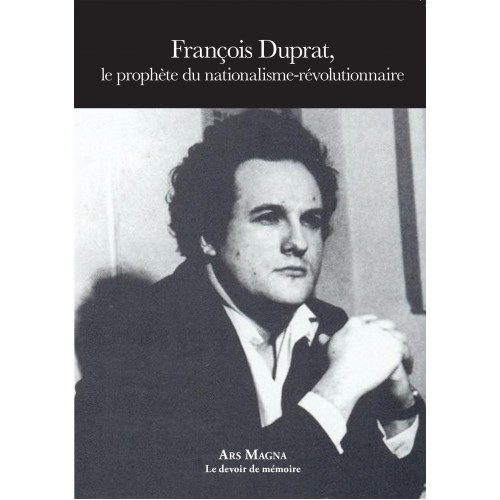
 François Duprat ne cachait pas qu’« il est clair aujourd’hui que la campagne de lutte contre l’immigration représentait la seule méthode utilisable ». En sortant le FN de ses thématiques classiques anti-communiste et anti-gaulliste, il avouait volontiers que « nous sommes des relativistes et que nous croyons à l’obligation pour les formulations idéologiques de s’adapter aux situations changeantes ». Sinon, « rester sur les vieilles positions, surannées et condamnées par les faits, c’est vouer notre camp à une défaite éternelle ». Ses préoccupations ne se limitent pas à la question sociale. Ainsi s’intéresse-t-il à l’écologie ! « Nous combattons pour que notre Terre ne soit pas ravagée et détruite par une “ civilisation ” qui anéantit rapidement ses richesses naturelles pour le seul profit final d’une petite clique d’exploiteurs. Les programmes de “ modernisation ” de notre espace territorial, le développement de l’énergie nucléaire, sont en train de détruire les bases mêmes de la vie de notre Peuple. » Parce que « l’hyper-capitalisme, comme le marxisme, sont issus, tous les deux, du monstrueux développement industriel du XIXe siècle et ils ont comme idée maîtresse la croyance en un progrès économique indéfini », « nous avons à lutter contre ceux qui ont transformé de vastes parties de notre planète en un dépotoir, pour augmenter qui la puissance politique d’une bureaucratie tyrannique, qui le taux de profit de certaines puissantes sociétés » avant d’affirmer que « l’écologie n’est qu’une projection de l’idéologie nationaliste-révolutionnaire ».
François Duprat ne cachait pas qu’« il est clair aujourd’hui que la campagne de lutte contre l’immigration représentait la seule méthode utilisable ». En sortant le FN de ses thématiques classiques anti-communiste et anti-gaulliste, il avouait volontiers que « nous sommes des relativistes et que nous croyons à l’obligation pour les formulations idéologiques de s’adapter aux situations changeantes ». Sinon, « rester sur les vieilles positions, surannées et condamnées par les faits, c’est vouer notre camp à une défaite éternelle ». Ses préoccupations ne se limitent pas à la question sociale. Ainsi s’intéresse-t-il à l’écologie ! « Nous combattons pour que notre Terre ne soit pas ravagée et détruite par une “ civilisation ” qui anéantit rapidement ses richesses naturelles pour le seul profit final d’une petite clique d’exploiteurs. Les programmes de “ modernisation ” de notre espace territorial, le développement de l’énergie nucléaire, sont en train de détruire les bases mêmes de la vie de notre Peuple. » Parce que « l’hyper-capitalisme, comme le marxisme, sont issus, tous les deux, du monstrueux développement industriel du XIXe siècle et ils ont comme idée maîtresse la croyance en un progrès économique indéfini », « nous avons à lutter contre ceux qui ont transformé de vastes parties de notre planète en un dépotoir, pour augmenter qui la puissance politique d’une bureaucratie tyrannique, qui le taux de profit de certaines puissantes sociétés » avant d’affirmer que « l’écologie n’est qu’une projection de l’idéologie nationaliste-révolutionnaire ».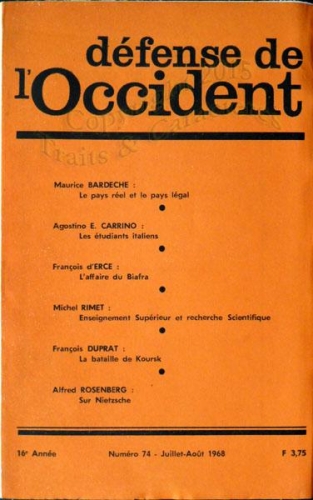 Cela ne l’empêchait pas de se pencher sur l’idée européenne à un moment où sa construction déjà pervertie n’en était qu’à ses balbutiements. « La France… mettons isolée (pour ne pas écorcher certaines oreilles) n’a jamais été un idéal admissible pour les militants de notre bord ayant le sens de l’Europe. » La nation française « peut et […] doit jouer un grand rôle au sein d’un rassemblement des nations européennes. Mais, là encore, la France, ne pourra participer à une union de l’Europe que si sa personnalité existe encore ». À propos du « fait français », il reconnaît que « nous sommes des ethnies diverses rassemblées en une seule nation et nous devons continuer ensemble notre chemin, en respectant scrupuleusement l’originalité de chacune des composantes de notre Entité historique ». La vocation du nationalisme-révolutionnaire n’est pas seulement d’envisager « la France comme une nation colonisée, qu’il est urgent de décoloniser. Les Français se croient libres alors qu’ils ne sont en vérité que les jouets de lobbies étrangers, qui les grugent et les exploitent, grâce à la complicité d’une fraction des classes dirigeantes, à qui ces lobbies jettent quelques morceaux de leur festin », mais aussi et surtout de considérer que « le Nationalisme est la défense de toutes les ethnies constituant le Peuple français, au sein de leur cadre historique, la Nation française, une Nation enfin délibérée et rendue à son destin ». Le nationalisme-révolutionnaire agit « pour la libération de tous les peuples d’Europe, soumis les uns au colonialisme sioniste, les autres au colonialisme marxiste ». Toutefois, attention !, « on ne construira pas l’Europe sur une éruption de micro-nationalismes, prévient-il, qui auraient toutes les chances de tourner très vite en chauvinisme et en racisme hostiles aux autres ethnies de notre nation ». Il en découle que « le nationalisme croît dans les régions, il ne prend pas appui sur des individus désincarnés, anonymes, mais sur des citoyens intégrés dans leurs régions d’origine. Il fait sienne la doctrine de l’enracinement et ne prêche pas un quelconque “ sous-jacobinisme ” centralisateur, destructeur des petites unités régionales ».
Cela ne l’empêchait pas de se pencher sur l’idée européenne à un moment où sa construction déjà pervertie n’en était qu’à ses balbutiements. « La France… mettons isolée (pour ne pas écorcher certaines oreilles) n’a jamais été un idéal admissible pour les militants de notre bord ayant le sens de l’Europe. » La nation française « peut et […] doit jouer un grand rôle au sein d’un rassemblement des nations européennes. Mais, là encore, la France, ne pourra participer à une union de l’Europe que si sa personnalité existe encore ». À propos du « fait français », il reconnaît que « nous sommes des ethnies diverses rassemblées en une seule nation et nous devons continuer ensemble notre chemin, en respectant scrupuleusement l’originalité de chacune des composantes de notre Entité historique ». La vocation du nationalisme-révolutionnaire n’est pas seulement d’envisager « la France comme une nation colonisée, qu’il est urgent de décoloniser. Les Français se croient libres alors qu’ils ne sont en vérité que les jouets de lobbies étrangers, qui les grugent et les exploitent, grâce à la complicité d’une fraction des classes dirigeantes, à qui ces lobbies jettent quelques morceaux de leur festin », mais aussi et surtout de considérer que « le Nationalisme est la défense de toutes les ethnies constituant le Peuple français, au sein de leur cadre historique, la Nation française, une Nation enfin délibérée et rendue à son destin ». Le nationalisme-révolutionnaire agit « pour la libération de tous les peuples d’Europe, soumis les uns au colonialisme sioniste, les autres au colonialisme marxiste ». Toutefois, attention !, « on ne construira pas l’Europe sur une éruption de micro-nationalismes, prévient-il, qui auraient toutes les chances de tourner très vite en chauvinisme et en racisme hostiles aux autres ethnies de notre nation ». Il en découle que « le nationalisme croît dans les régions, il ne prend pas appui sur des individus désincarnés, anonymes, mais sur des citoyens intégrés dans leurs régions d’origine. Il fait sienne la doctrine de l’enracinement et ne prêche pas un quelconque “ sous-jacobinisme ” centralisateur, destructeur des petites unités régionales ».

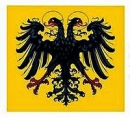
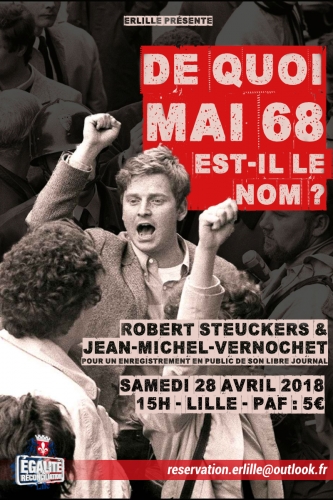

 del.icio.us
del.icio.us
 Digg
Digg
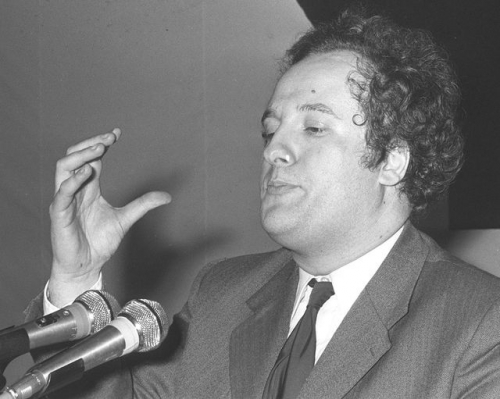


 The Law of Civilization and Decay was published in 1896; that is, several decades prior to Spengler’s Decline of the West. Like Spengler, Adams traces through the analogous epochs of Civilizations the impact these epochs have upon the Culture in its entirety, from architecture to politics, focusing on the economic influences. He shows, like Spengler, that Civilizations proceed through organic cycles. Spengler used the names of seasons to illustrate the organic character of culture-life, going through the stages of birth (Spring; Culture), youthful vigor (Summer, High Culture), maturity (Autumn, Civilization), old age and senility (Winter), with an intervening era of revival – a dramatic final bow on the world stage – ending in death due to the primacy of money over spirit.
The Law of Civilization and Decay was published in 1896; that is, several decades prior to Spengler’s Decline of the West. Like Spengler, Adams traces through the analogous epochs of Civilizations the impact these epochs have upon the Culture in its entirety, from architecture to politics, focusing on the economic influences. He shows, like Spengler, that Civilizations proceed through organic cycles. Spengler used the names of seasons to illustrate the organic character of culture-life, going through the stages of birth (Spring; Culture), youthful vigor (Summer, High Culture), maturity (Autumn, Civilization), old age and senility (Winter), with an intervening era of revival – a dramatic final bow on the world stage – ending in death due to the primacy of money over spirit.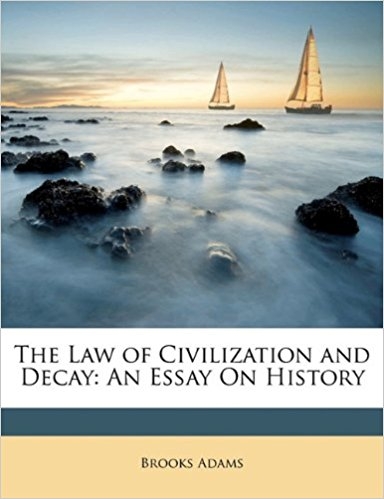 Adams’ theory of energy seems akin to C. G. Jung on the ‘canalisation’ of psychical energy (libido);
Adams’ theory of energy seems akin to C. G. Jung on the ‘canalisation’ of psychical energy (libido); At this level, all Civilisations enter upon a stage, which lasts for centuries, of appalling depopulation. The whole pyramid of cultural man vanishes. It crumbles from the summit, first the world-cities, then the provincial forms, and finally the land itself, whose best blood has incontinently poured into the towns, merely to bolster them up awhile, at the last. Only the primitive blood remains, alive, but robbed of its strongest and most promising elements. This residue is the Fellah type.
At this level, all Civilisations enter upon a stage, which lasts for centuries, of appalling depopulation. The whole pyramid of cultural man vanishes. It crumbles from the summit, first the world-cities, then the provincial forms, and finally the land itself, whose best blood has incontinently poured into the towns, merely to bolster them up awhile, at the last. Only the primitive blood remains, alive, but robbed of its strongest and most promising elements. This residue is the Fellah type. Where there were slaves imported from the subject peoples, long since etiolated, filling an Italy whose population was being denuded, there is today an analogous process in an analogous epoch: that of immigration from the ‘third world’ into the Western states whose populations are ageing. Oligarchy constituted the core of the Empire. Nobility became defined by wealth.
Where there were slaves imported from the subject peoples, long since etiolated, filling an Italy whose population was being denuded, there is today an analogous process in an analogous epoch: that of immigration from the ‘third world’ into the Western states whose populations are ageing. Oligarchy constituted the core of the Empire. Nobility became defined by wealth.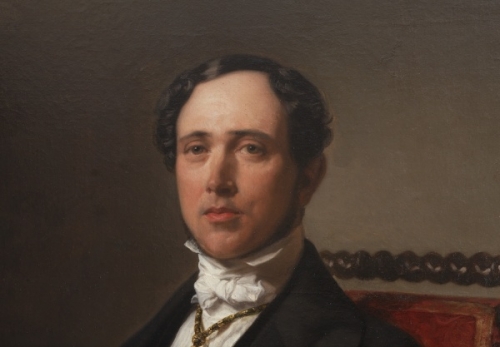
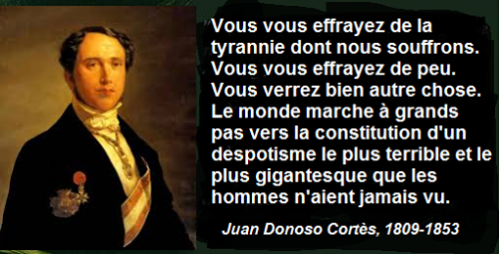

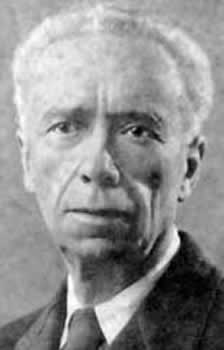 Lorsqu’il s’agit d’aborder le cas Georges Valois (1878-1945), c’est peut-être le terme de « rupture » qui s’impose en premier lieu à l’esprit. En effet, ce singulier personnage aura successivement adhéré aux idéologies marquantes de l’âge des extrêmes, de l’anarchisme à l’Action française (dont il sera un des premiers dissidents), d’un fascisme à la française clairement revendiqué au syndicalisme, jusqu’à enfin une doctrine économique trop peu étudiée encore, « l’abondancisme ».
Lorsqu’il s’agit d’aborder le cas Georges Valois (1878-1945), c’est peut-être le terme de « rupture » qui s’impose en premier lieu à l’esprit. En effet, ce singulier personnage aura successivement adhéré aux idéologies marquantes de l’âge des extrêmes, de l’anarchisme à l’Action française (dont il sera un des premiers dissidents), d’un fascisme à la française clairement revendiqué au syndicalisme, jusqu’à enfin une doctrine économique trop peu étudiée encore, « l’abondancisme ». Le livre, « virulent et écrit à chaud » selon les termes mêmes d’Olivier Dard, constitue un témoignage de première main sur une période de l’histoire souvent négligée au bénéfice des années 30, identifiées comme celles de tous les périls, de toutes les crises, de toutes les passions. Pourtant, quel bouillonnement déjà dans cette France qui sort à peine des tranchées, de la boue et du sang. L’heure est à la reconstruction et à la recherche de nouveaux modèles de société. Les uns ne jurent que par le monde anglo-saxon, les autres penchent plutôt du côté des Soviets. Valois revendique quant à lui l’ouverture d’une troisième voie dès l’incipit : « Ni Londres, ni Moscou. »
Le livre, « virulent et écrit à chaud » selon les termes mêmes d’Olivier Dard, constitue un témoignage de première main sur une période de l’histoire souvent négligée au bénéfice des années 30, identifiées comme celles de tous les périls, de toutes les crises, de toutes les passions. Pourtant, quel bouillonnement déjà dans cette France qui sort à peine des tranchées, de la boue et du sang. L’heure est à la reconstruction et à la recherche de nouveaux modèles de société. Les uns ne jurent que par le monde anglo-saxon, les autres penchent plutôt du côté des Soviets. Valois revendique quant à lui l’ouverture d’une troisième voie dès l’incipit : « Ni Londres, ni Moscou. »
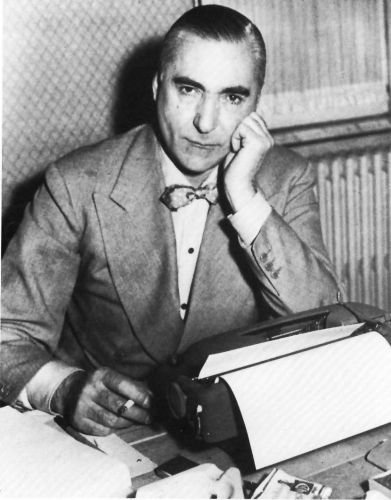 — Lorsqu’on lit le chapitre consacré à la rupture avec l’AF, on entrevoit qu’il s’agit moins d’une dissension à propos des idées que d’histoires de gros sous et de concurrence d’organes de presse (L’Action française contre le Nouveau Siècle) qui motivent le départ de Valois. Aux yeux de l’historien, ce récit est-il sincère et complet ?
— Lorsqu’on lit le chapitre consacré à la rupture avec l’AF, on entrevoit qu’il s’agit moins d’une dissension à propos des idées que d’histoires de gros sous et de concurrence d’organes de presse (L’Action française contre le Nouveau Siècle) qui motivent le départ de Valois. Aux yeux de l’historien, ce récit est-il sincère et complet ?




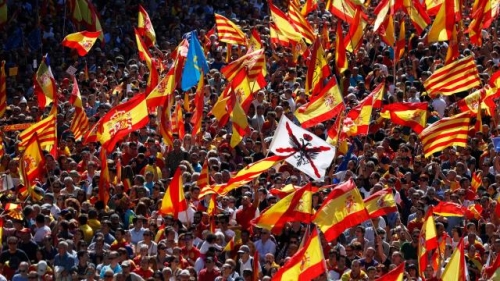

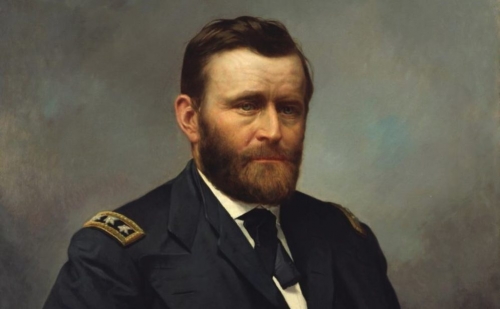
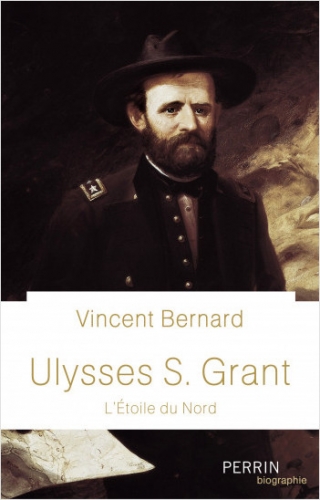 Ulysses S. Grant n’a pas eu une vie mais plusieurs. Vincent Bernard nous fait découvrir celui qui fut tour à tour, un enfant timide et effacé de l
Ulysses S. Grant n’a pas eu une vie mais plusieurs. Vincent Bernard nous fait découvrir celui qui fut tour à tour, un enfant timide et effacé de l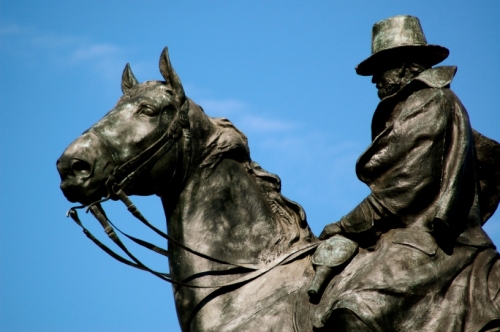
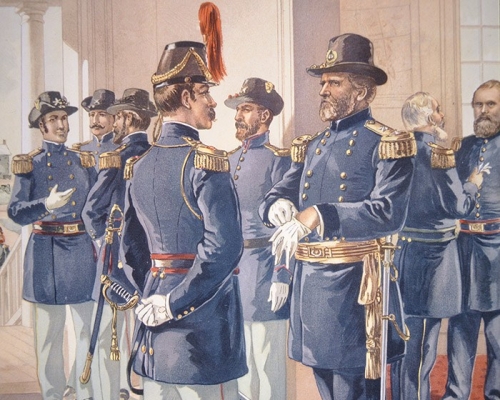
 Grant est lucide au sujet de cette Guerre Civile. Voici comment il la considère.
Grant est lucide au sujet de cette Guerre Civile. Voici comment il la considère. 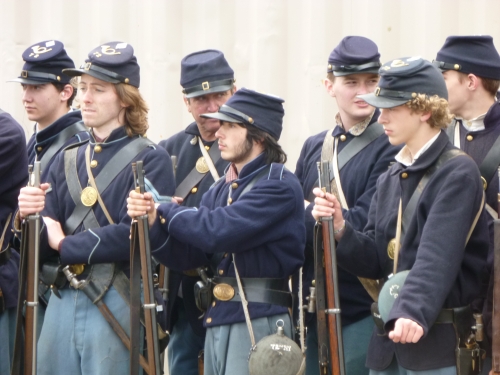 De son vivant et après sa mort, d’aucuns opposeront le «
De son vivant et après sa mort, d’aucuns opposeront le « 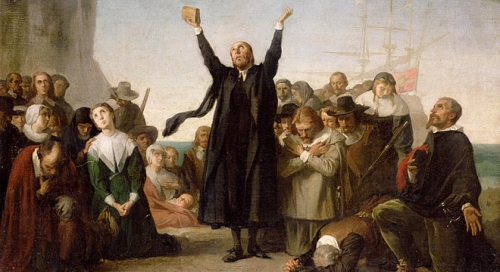
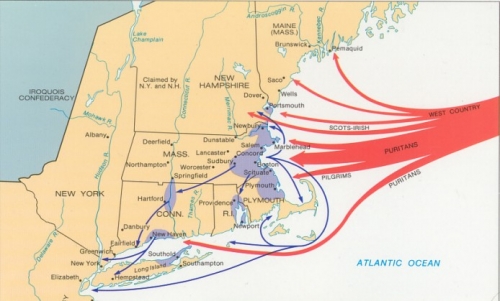
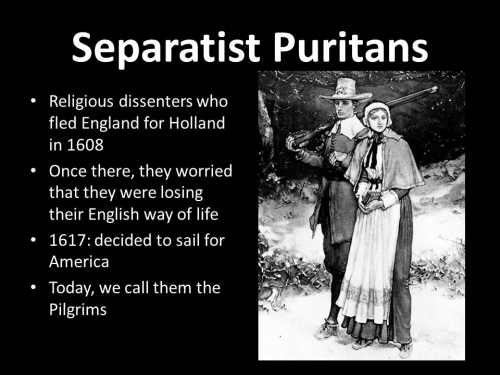
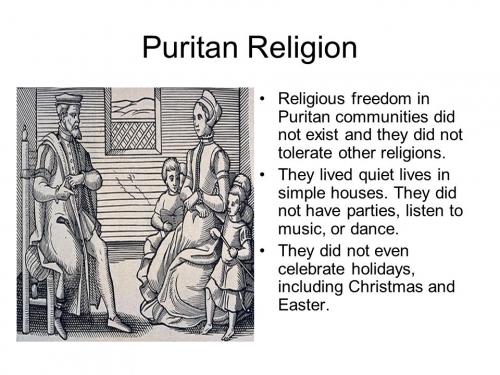

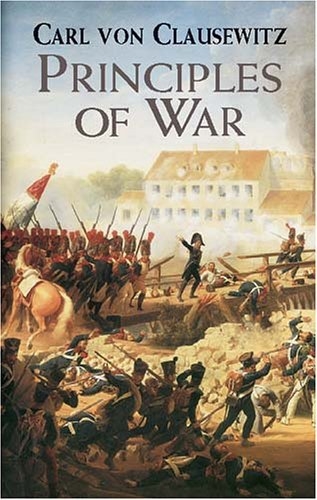 Oltre a questa differenza di fatto esistente nelle guerre, va stabilito in modo esplicito e preciso anche il punto di vista – pure praticamente necessario – secondo cui la guerra non è niente altro che la politica dello Stato proseguita con altri mezzi. Questo punto di vista, tenuto ben fermo dappertutto, darà unità a questa trattazione saggistica. E tutto sarà quindi più facile da districare.
Oltre a questa differenza di fatto esistente nelle guerre, va stabilito in modo esplicito e preciso anche il punto di vista – pure praticamente necessario – secondo cui la guerra non è niente altro che la politica dello Stato proseguita con altri mezzi. Questo punto di vista, tenuto ben fermo dappertutto, darà unità a questa trattazione saggistica. E tutto sarà quindi più facile da districare. Centrando il nostro pensiero sulla politica, per poi passare alla guerra, è necessario soffermarsi su questo punto. La politica è un conflitto di interessi, si fonda su di essi e si basa su rapporti di forza, vale a dire su rapporti tra individui che pensano e agiscono in modo da raggiungere i loro scopi. Sicché si può divergere per almeno due ragioni: si diverge sul fine o si diverge sul mezzo, o su entrambi. La politica ammette diversificazione di partiti non solo in virtù dello scopo finale, cioè un peculiare ordinamento sociale o economico, ma pure sui mezzi attraverso cui raggiungere lo scopo. I comunisti e i socialisti non avevano grandi distinzioni in merito ai fini, ma grandi differenze sussistevano nella concezione dei mezzi attraverso cui raggiungere gli scopi.
Centrando il nostro pensiero sulla politica, per poi passare alla guerra, è necessario soffermarsi su questo punto. La politica è un conflitto di interessi, si fonda su di essi e si basa su rapporti di forza, vale a dire su rapporti tra individui che pensano e agiscono in modo da raggiungere i loro scopi. Sicché si può divergere per almeno due ragioni: si diverge sul fine o si diverge sul mezzo, o su entrambi. La politica ammette diversificazione di partiti non solo in virtù dello scopo finale, cioè un peculiare ordinamento sociale o economico, ma pure sui mezzi attraverso cui raggiungere lo scopo. I comunisti e i socialisti non avevano grandi distinzioni in merito ai fini, ma grandi differenze sussistevano nella concezione dei mezzi attraverso cui raggiungere gli scopi.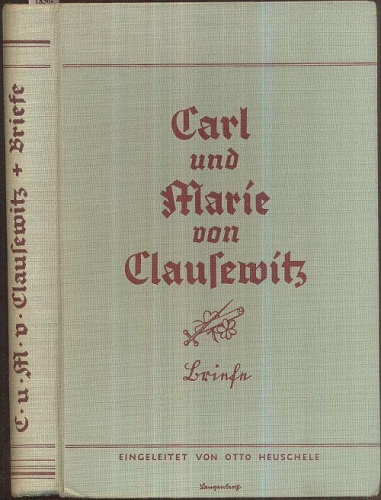 Ogni attore politico ammette tre generi di relazioni con un altro attore politico: alleanza, indifferenza, ostilità. Nel caso in cui le due parti in contrapposizione non trovino alcun genere di accordo possibile né sui fini da raggiungere, né sui mezzi, e sono propensi a darsi battaglia per ottenere la vittoria sull’altro, si giunge al conflitto. Se il conflitto è di natura sociale, si parla di lotta politica; se il conflitto è di natura armata, si parla di guerra. Politica e guerra sono solo due casi particolari della logica del conflitto e la guerra è, a sua volta, una peculiare forma della politica. Perché è solo l’interesse politico a determinare la volontà di combattere per mezzo delle armi.
Ogni attore politico ammette tre generi di relazioni con un altro attore politico: alleanza, indifferenza, ostilità. Nel caso in cui le due parti in contrapposizione non trovino alcun genere di accordo possibile né sui fini da raggiungere, né sui mezzi, e sono propensi a darsi battaglia per ottenere la vittoria sull’altro, si giunge al conflitto. Se il conflitto è di natura sociale, si parla di lotta politica; se il conflitto è di natura armata, si parla di guerra. Politica e guerra sono solo due casi particolari della logica del conflitto e la guerra è, a sua volta, una peculiare forma della politica. Perché è solo l’interesse politico a determinare la volontà di combattere per mezzo delle armi. Allo stesso tempo, con l’avanzare della tecnica e delle conoscenze scientifiche, le guerre cambiano di strumenti ma non nella sostanza. La natura dei fini umani è sempre la stessa, non cambia in base alle epoche storiche: ciò che cambia è l’oggetto, non l’intenzione verso di esso. In questo senso, la guerra, non solo nel suo farsi ma anche nel suo concetto, è di natura permanentemente multiforme. Essa cambia nei mezzi e negli scopi, cioè muta totalmente di forma. È la forma della guerra, non le sue ragioni profonde, a costituire la ragione fondamentale della diversità dei conflitti armati della storia. Eppure, a partire dalla comprensione della guerra nel suo ruolo di strumento politico, si nota una lunga linea di continuità tra i vari fenomeni bellici.
Allo stesso tempo, con l’avanzare della tecnica e delle conoscenze scientifiche, le guerre cambiano di strumenti ma non nella sostanza. La natura dei fini umani è sempre la stessa, non cambia in base alle epoche storiche: ciò che cambia è l’oggetto, non l’intenzione verso di esso. In questo senso, la guerra, non solo nel suo farsi ma anche nel suo concetto, è di natura permanentemente multiforme. Essa cambia nei mezzi e negli scopi, cioè muta totalmente di forma. È la forma della guerra, non le sue ragioni profonde, a costituire la ragione fondamentale della diversità dei conflitti armati della storia. Eppure, a partire dalla comprensione della guerra nel suo ruolo di strumento politico, si nota una lunga linea di continuità tra i vari fenomeni bellici.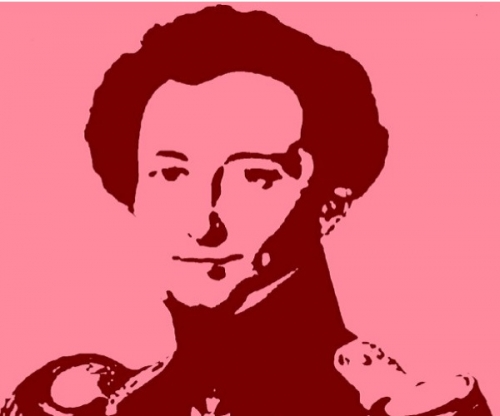
 Lenin y Trotsky recuperarían sus definiciones dándoles terrenalidad en la experiencia misma de la revolución: en el evento por antonomasia del pasaje de la política a la lucha física: la ciencia y arte de la insurrección: el momento en que se rompe el continuum de la historia con la intervención de las masas comandadas por el partido revolucionario, que se hacen del poder y cambian la historia.
Lenin y Trotsky recuperarían sus definiciones dándoles terrenalidad en la experiencia misma de la revolución: en el evento por antonomasia del pasaje de la política a la lucha física: la ciencia y arte de la insurrección: el momento en que se rompe el continuum de la historia con la intervención de las masas comandadas por el partido revolucionario, que se hacen del poder y cambian la historia.
 De ahí que muchos de los conceptos de la guerra se vean aplicados a la política, ya que ésta es, como la guerra, un campo para hacer valer determinadas relaciones de fuerza. Sin duda, las relaciones de fuerza políticas se hacen valer mediante un complejo de relaciones mayor y más rico que el de la violencia desnuda, pero en el fondo en el terreno político también se trata de vencer la resistencia del oponente.
De ahí que muchos de los conceptos de la guerra se vean aplicados a la política, ya que ésta es, como la guerra, un campo para hacer valer determinadas relaciones de fuerza. Sin duda, las relaciones de fuerza políticas se hacen valer mediante un complejo de relaciones mayor y más rico que el de la violencia desnuda, pero en el fondo en el terreno político también se trata de vencer la resistencia del oponente. Tal era la posición del general alemán de la I Guerra Mundial, Erich von Ludendorff, autor de la obra La guerra total (1935), donde criticaba a Clausewitz desde una posición reduccionista que ponía en el centro de las determinaciones a la categoría de “guerra total”, a la que independizaba de la política negando el concepto clausewitziano de “guerra absoluta”, que necesariamente se ve limitado por las determinaciones políticas.
Tal era la posición del general alemán de la I Guerra Mundial, Erich von Ludendorff, autor de la obra La guerra total (1935), donde criticaba a Clausewitz desde una posición reduccionista que ponía en el centro de las determinaciones a la categoría de “guerra total”, a la que independizaba de la política negando el concepto clausewitziano de “guerra absoluta”, que necesariamente se ve limitado por las determinaciones políticas.


 Esta era una preocupación característica de Rosa Luxemburgo, que insistía en la necesidad de aprender de la experiencia real de la clase obrera, contra el conservadurismo pedante y de aparato de la vieja socialdemocracia.
Esta era una preocupación característica de Rosa Luxemburgo, que insistía en la necesidad de aprender de la experiencia real de la clase obrera, contra el conservadurismo pedante y de aparato de la vieja socialdemocracia. Este problema es clásico a toda gran revolución. Si la Revolución Francesa de 1789 logró triunfar es porque desde su centro excluyente, París, logró arrastrar tras de sí al resto del país. Algo que no consiguió la Comuna de París cien años después, lo que determinó su derrota. El mismo déficit tuvo el levantamiento espartaquista de enero de 1919 en Alemania, derrotado a sangre y fuego porque el interior campesino y pequeño-burgués no logró ser arrastrado. Multitudinarias movilizaciones ocurrían en Berlín enfervorizando a sus dirigentes (sobre todo a Karl Liebknecht; Rosa era consciente de que se iba al desastre), mientras que en el interior el ejército alemán se iba reforzando y fortaleciendo con el apoyo del campesinado y demás sectores conservadores.
Este problema es clásico a toda gran revolución. Si la Revolución Francesa de 1789 logró triunfar es porque desde su centro excluyente, París, logró arrastrar tras de sí al resto del país. Algo que no consiguió la Comuna de París cien años después, lo que determinó su derrota. El mismo déficit tuvo el levantamiento espartaquista de enero de 1919 en Alemania, derrotado a sangre y fuego porque el interior campesino y pequeño-burgués no logró ser arrastrado. Multitudinarias movilizaciones ocurrían en Berlín enfervorizando a sus dirigentes (sobre todo a Karl Liebknecht; Rosa era consciente de que se iba al desastre), mientras que en el interior el ejército alemán se iba reforzando y fortaleciendo con el apoyo del campesinado y demás sectores conservadores. El partido no agrupa a los trabajadores por su condición de tales sino solamente aquéllos que han avanzado a la comprensión de que la solución a los problemas pasa por la revolución socialista: el partido agrupa a los revolucionarios y no a los trabajadores en general (cuya abrumadora mayoría es de ideología burguesa, reformista y no revolucionaria).
El partido no agrupa a los trabajadores por su condición de tales sino solamente aquéllos que han avanzado a la comprensión de que la solución a los problemas pasa por la revolución socialista: el partido agrupa a los revolucionarios y no a los trabajadores en general (cuya abrumadora mayoría es de ideología burguesa, reformista y no revolucionaria).


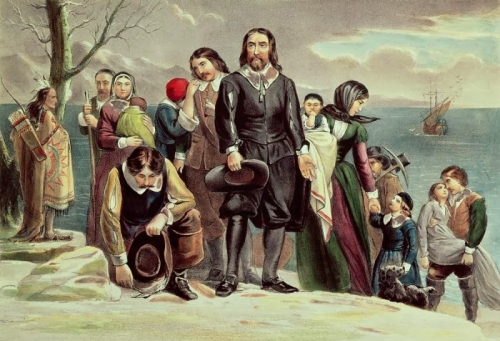
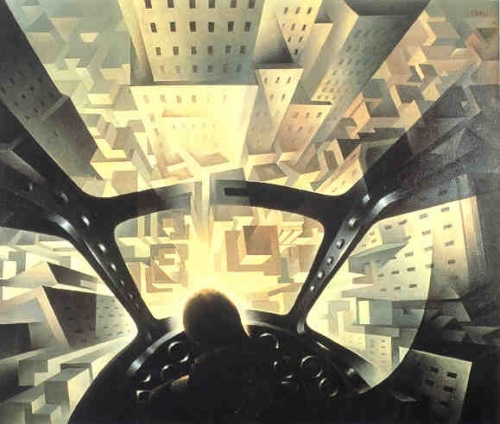

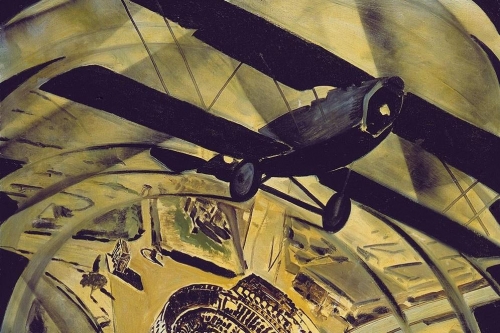

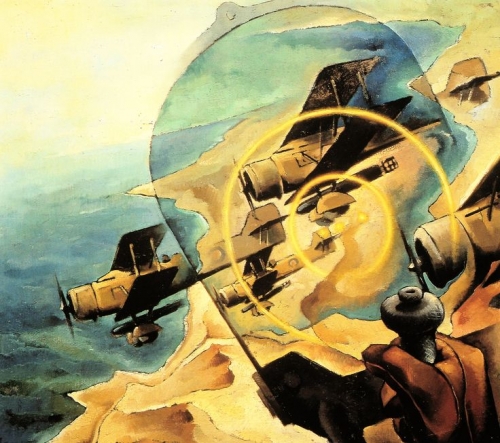
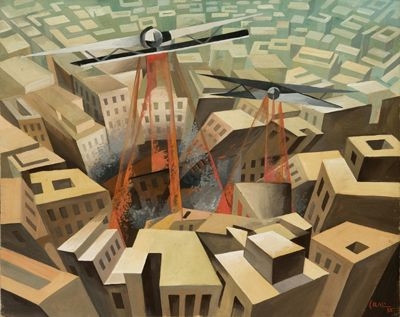
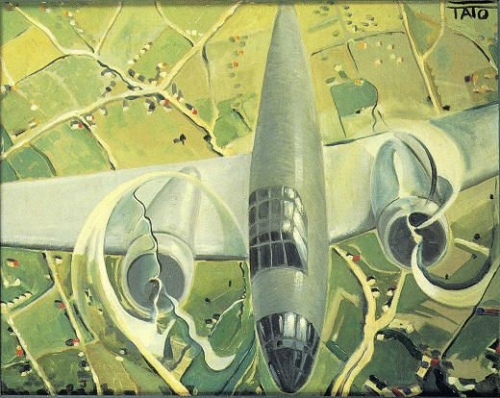

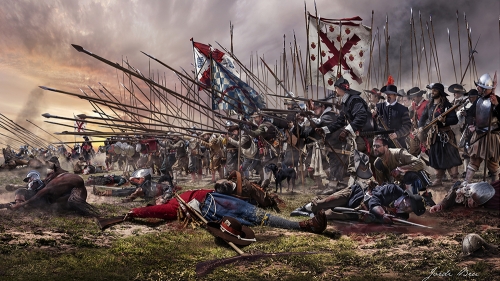
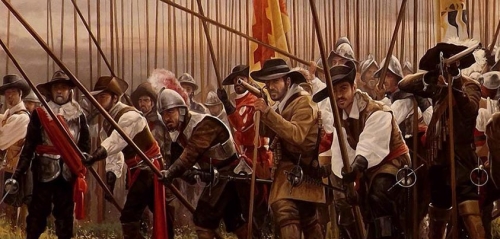
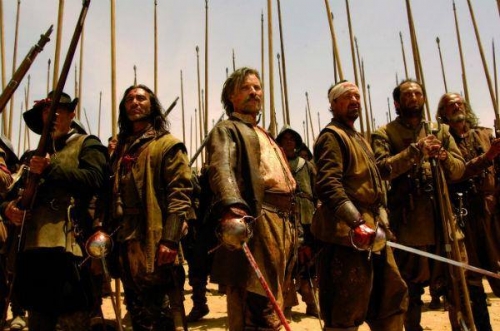
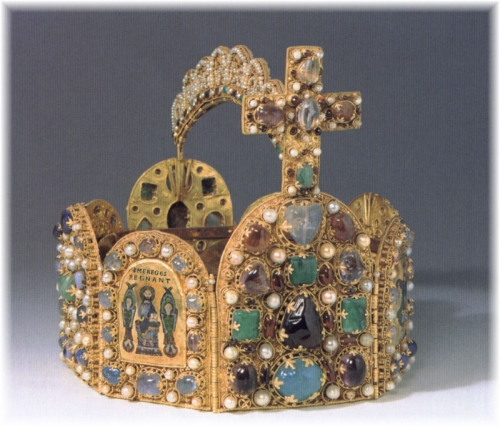

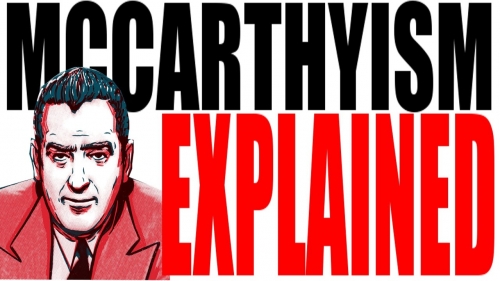
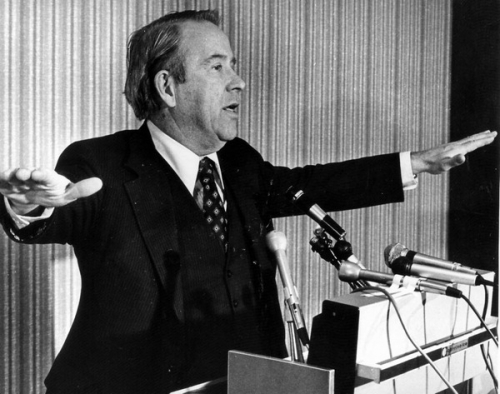
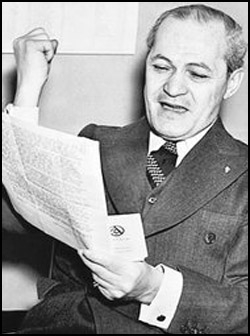 » La HUAC avait été mise en place à la Chambre des Représentants en 1934
» La HUAC avait été mise en place à la Chambre des Représentants en 1934 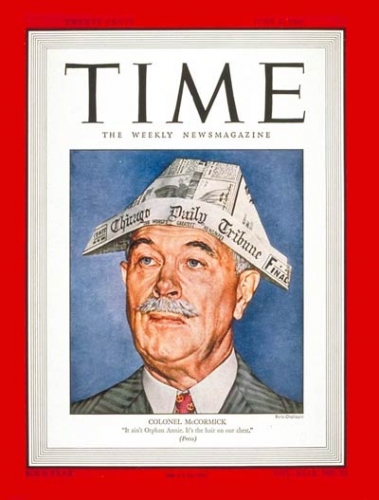 » Ce n'était que la plus visible des mesures répressives qui furent prises lors de la “Brown Scare” et qui furent ensuite réutilisées lors de la “Red Scare”. Il s’agissait d’un simple ajustement suivant le tournant de la politique étrangère américaine et un changement ultérieur de l'opinion publique américaine. Le FBI avait infiltré des groupes comme le Comité America First qui s'opposait à l'entrée des Etats-Unis dans la Seconde Guerre mondiale, il avait mis sur écoutes des dirigeants conservateurs tel que le directeur du Chicago Tribune Robert McCormick ; il suffisait alors de réorienter toutes ces procédures vers les cibles de gauche. Mais rappelez-vous l’essentiel : c’est la gauche qui lança tout cela et fit mettre en place la répression dans toute son ampleur, alors qu’elle tenait le fouet.
» Ce n'était que la plus visible des mesures répressives qui furent prises lors de la “Brown Scare” et qui furent ensuite réutilisées lors de la “Red Scare”. Il s’agissait d’un simple ajustement suivant le tournant de la politique étrangère américaine et un changement ultérieur de l'opinion publique américaine. Le FBI avait infiltré des groupes comme le Comité America First qui s'opposait à l'entrée des Etats-Unis dans la Seconde Guerre mondiale, il avait mis sur écoutes des dirigeants conservateurs tel que le directeur du Chicago Tribune Robert McCormick ; il suffisait alors de réorienter toutes ces procédures vers les cibles de gauche. Mais rappelez-vous l’essentiel : c’est la gauche qui lança tout cela et fit mettre en place la répression dans toute son ampleur, alors qu’elle tenait le fouet.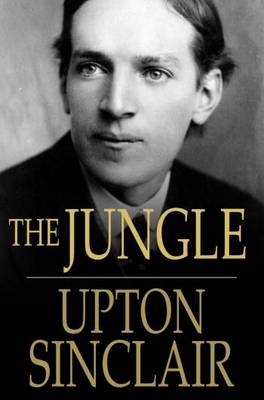 (D’un autre côté, Roosevelt, qui était d’abord un politicien roué assez éloigné de l’image idéalisée qu’on en fit et qui persiste, s’opposait aux tentatives légales d’avancement trop affirmé de la gauche radicale, comme par exemple lorsqu’il sabota indirectement la campagne de l’écrivain
(D’un autre côté, Roosevelt, qui était d’abord un politicien roué assez éloigné de l’image idéalisée qu’on en fit et qui persiste, s’opposait aux tentatives légales d’avancement trop affirmé de la gauche radicale, comme par exemple lorsqu’il sabota indirectement la campagne de l’écrivain 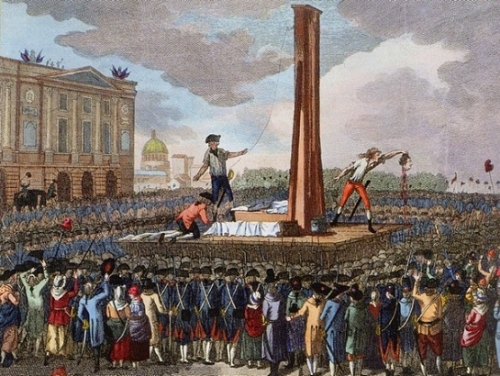

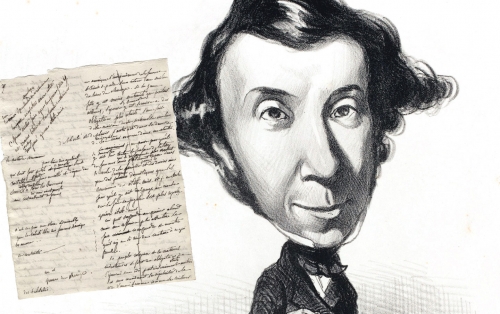
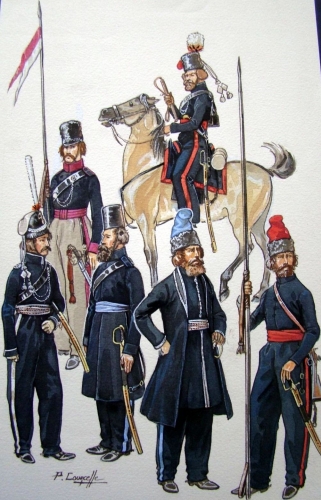 Tocqueville décrit cette préparation à la grande guerre européenne (et je crois que mon ami
Tocqueville décrit cette préparation à la grande guerre européenne (et je crois que mon ami 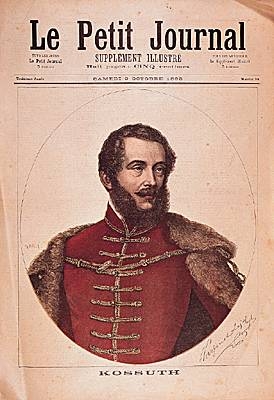 Puis Tocqueville met les pieds dans le plat sans mâcher ses mots cette fois :
Puis Tocqueville met les pieds dans le plat sans mâcher ses mots cette fois : Comme notre Poutine, le tzar Nicolas garde son sang-froid :
Comme notre Poutine, le tzar Nicolas garde son sang-froid :

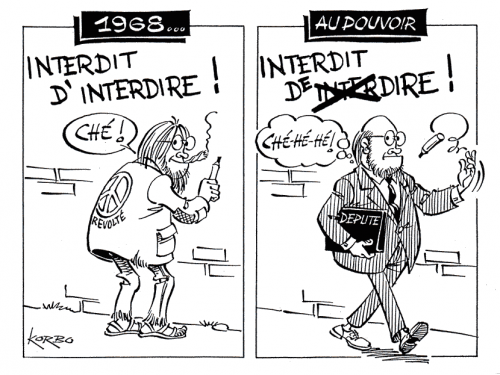

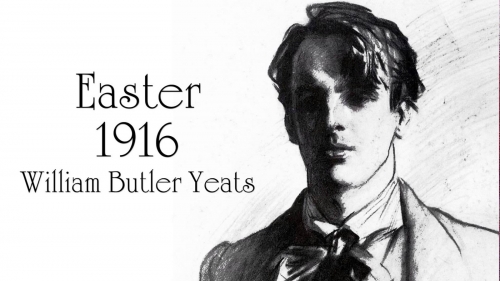
 At an early age Yeats became involved in mysticism which would prove controversial his whole life. Kodani explains, “The early poetry of William Butler Yeats was very much bound up with the forces and interests of his early years. Many of these influences — such as that of Maud Gonne, his father, and his own mystic studies — have been elucidated by some careful scholarship.” Yeats’ writing was influenced by his study of mysticism. He joined the Theosophical Society as his immediate family’s tradition was not very religious. Later he “became interested in esoteric philosophy, and in 1890 was initiated into the Hermetic Order of the Golden Dawn” (Seymour-Smith). He would pursue mystical philosophy the rest of his life to a greater or lesser degree.
At an early age Yeats became involved in mysticism which would prove controversial his whole life. Kodani explains, “The early poetry of William Butler Yeats was very much bound up with the forces and interests of his early years. Many of these influences — such as that of Maud Gonne, his father, and his own mystic studies — have been elucidated by some careful scholarship.” Yeats’ writing was influenced by his study of mysticism. He joined the Theosophical Society as his immediate family’s tradition was not very religious. Later he “became interested in esoteric philosophy, and in 1890 was initiated into the Hermetic Order of the Golden Dawn” (Seymour-Smith). He would pursue mystical philosophy the rest of his life to a greater or lesser degree.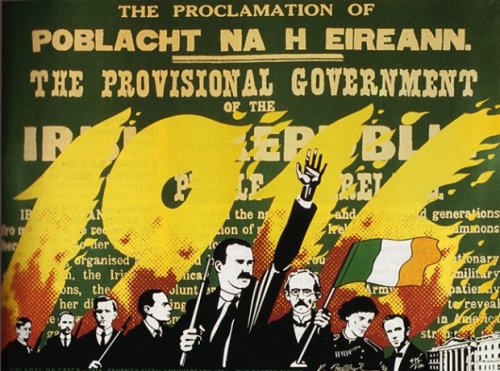

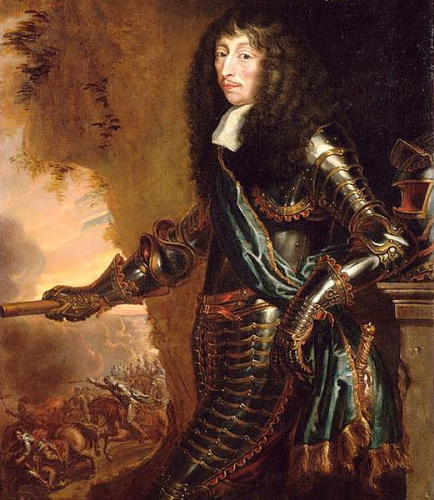

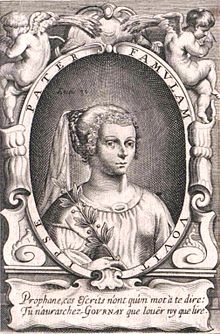 La révolte poétique sera l’expression d’un refus de cette expression culturelle de la Raison d’Etat. Les champions en seront, dans le domaine théâtral, Hardy, le grand Corneille lui-même, avant qu’il ne se convertisse aux règles, et en poésie, Régnier, anti-conformiste, individualiste original, Théophile de Viau, libertin converti, qui, bien que « moderniste », avait toujours sous sa plume le mot de « franchise », mort à 36 ans après avoir été mis au cachot par les cagots, Boisrobert, sévère pour un siècle voué à l’argent, Saint-Amant, La Ménardière, qui célébra « le grand Ronsard », le concettiste Tristan… Tous ces écrivains sont des êtres de plein air, des amants de la liberté, de la libre expression de soi, sans laquelle il n’est pas de noblesse. Même Sorel, le satirique qui ne l’aimait pas, louait « l’âme véritablement généreuse ». (1) Et il n’est pas d’auteur exprimant mieux cette aspiration qu’Honoré d’Urfé, qui a donné à la France l’exquis roman pastoral L’Astrée, qu’il situe dans le Forez, au milieu des bergers et des druides. Rien de plus étranger à l’ancien ligueur catholique que la médiocrité. Il prône une éthique platonicienne, fondée sur l’amour, le sublime, l’enthousiasme, la générosité, tous mouvements de l’âme et du cœur qui portent le fini vers Dieu. Honoré d’Urfé, c’est l’anti-Descartes, le négateur de l’esprit géométrique. Racan le suivra dans ses Bergeries, célébrant l’âge d’or. Mais l’Astrée est une utopie dans un siècle qui s’adonne à l’intérêt, à l’utilité, à l’ambition calculée, à la ruse, à la mathématique appliquée.
La révolte poétique sera l’expression d’un refus de cette expression culturelle de la Raison d’Etat. Les champions en seront, dans le domaine théâtral, Hardy, le grand Corneille lui-même, avant qu’il ne se convertisse aux règles, et en poésie, Régnier, anti-conformiste, individualiste original, Théophile de Viau, libertin converti, qui, bien que « moderniste », avait toujours sous sa plume le mot de « franchise », mort à 36 ans après avoir été mis au cachot par les cagots, Boisrobert, sévère pour un siècle voué à l’argent, Saint-Amant, La Ménardière, qui célébra « le grand Ronsard », le concettiste Tristan… Tous ces écrivains sont des êtres de plein air, des amants de la liberté, de la libre expression de soi, sans laquelle il n’est pas de noblesse. Même Sorel, le satirique qui ne l’aimait pas, louait « l’âme véritablement généreuse ». (1) Et il n’est pas d’auteur exprimant mieux cette aspiration qu’Honoré d’Urfé, qui a donné à la France l’exquis roman pastoral L’Astrée, qu’il situe dans le Forez, au milieu des bergers et des druides. Rien de plus étranger à l’ancien ligueur catholique que la médiocrité. Il prône une éthique platonicienne, fondée sur l’amour, le sublime, l’enthousiasme, la générosité, tous mouvements de l’âme et du cœur qui portent le fini vers Dieu. Honoré d’Urfé, c’est l’anti-Descartes, le négateur de l’esprit géométrique. Racan le suivra dans ses Bergeries, célébrant l’âge d’or. Mais l’Astrée est une utopie dans un siècle qui s’adonne à l’intérêt, à l’utilité, à l’ambition calculée, à la ruse, à la mathématique appliquée. 

 Qui est Xavier de Grunne ?
Qui est Xavier de Grunne ?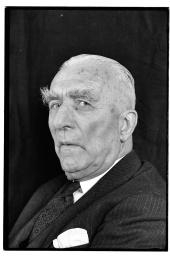 Pierre Nothomb, fondateur au cours des années 1920 des Jeunesses nationales, a été inquiété à plusieurs reprises durant la guerre par les Allemands pour ses actes de résistance. La Légion Nationale, organisation nationaliste belge fondée en 1922 et qui devient ensuite un mouvement d’Ordre nouveau qui affronte physiquement les milices socialistes et communistes, entre dès le début de l’occupation dans la Résistance. Plusieurs de ses membres sont fusillés par les Allemands et son dirigeant, l’avocat Paul Hoornaert, meurt en déportation. Un certain nombre de rexistes ou d’anciens rexistes se sont également retrouvés dans la Résistance. L’écrivain Robert du Bois de Vroylande, ainsi que le rédacteur en chef du quotidien rexiste Le Pays Réel et membre du Conseil politique du mouvement rexiste Hubert d’Ydewalle, qui ont tous deux rompu avec Rex avant la guerre, meurent en déportation. Le Mouvement National Royaliste (Nationale Koninklijke Beweging), une des organisations de résistance du pays, est fondé par des rexistes restés fidèles au Roi Léopold III. Ajoutons que les intellectuels adeptes de l’Ordre nouveau et professeurs d’université Fernand Desonay et Charles Terlinden se sont retrouvés eux aussi dans la Résistance.
Pierre Nothomb, fondateur au cours des années 1920 des Jeunesses nationales, a été inquiété à plusieurs reprises durant la guerre par les Allemands pour ses actes de résistance. La Légion Nationale, organisation nationaliste belge fondée en 1922 et qui devient ensuite un mouvement d’Ordre nouveau qui affronte physiquement les milices socialistes et communistes, entre dès le début de l’occupation dans la Résistance. Plusieurs de ses membres sont fusillés par les Allemands et son dirigeant, l’avocat Paul Hoornaert, meurt en déportation. Un certain nombre de rexistes ou d’anciens rexistes se sont également retrouvés dans la Résistance. L’écrivain Robert du Bois de Vroylande, ainsi que le rédacteur en chef du quotidien rexiste Le Pays Réel et membre du Conseil politique du mouvement rexiste Hubert d’Ydewalle, qui ont tous deux rompu avec Rex avant la guerre, meurent en déportation. Le Mouvement National Royaliste (Nationale Koninklijke Beweging), une des organisations de résistance du pays, est fondé par des rexistes restés fidèles au Roi Léopold III. Ajoutons que les intellectuels adeptes de l’Ordre nouveau et professeurs d’université Fernand Desonay et Charles Terlinden se sont retrouvés eux aussi dans la Résistance.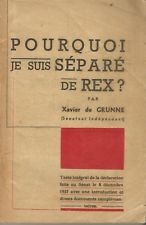 Contrairement à ce qui a été souvent écrit, il apparaît que Xavier de Grunne est resté lié à Rex jusqu’en 1939, et que la rupture annoncée en 1937 au sein de l’ouvrage de Xavier de Grunne intitulé Pourquoi je suis séparé de Rex ? est purement stratégique afin de disposer de la liberté de pouvoir critiquer l’Église qui attaque Rex, tout en ne froissant pas les électeurs rexistes qui sont pour la plupart des catholiques convaincus.
Contrairement à ce qui a été souvent écrit, il apparaît que Xavier de Grunne est resté lié à Rex jusqu’en 1939, et que la rupture annoncée en 1937 au sein de l’ouvrage de Xavier de Grunne intitulé Pourquoi je suis séparé de Rex ? est purement stratégique afin de disposer de la liberté de pouvoir critiquer l’Église qui attaque Rex, tout en ne froissant pas les électeurs rexistes qui sont pour la plupart des catholiques convaincus.